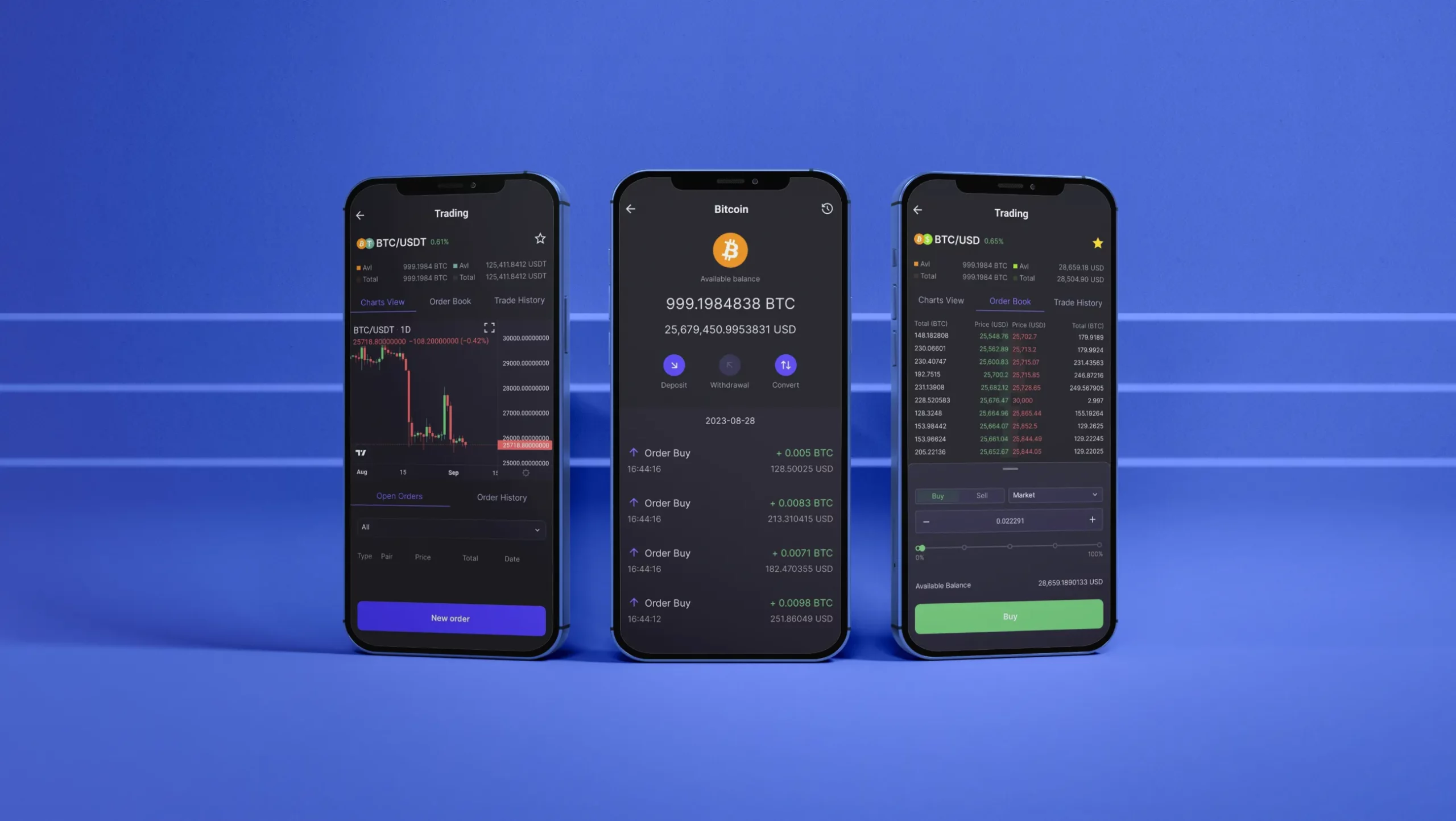- Crypto Solutions
- By business model
- By auction model
- Services
- Case studies
- Contact
Leverage trading, also known as margin trading, has become a prominent strategy in the financial world, especially in the crypto industry. This trading method allows investors to control more significant positions in the market with a relatively small amount of capital.
In this guide, we’ll explore what leverage trading is, how it works, its advantages and disadvantages. Also, we will discuss risks involved and how to avoid them. You will learn how to choose the right broker and whether trading with leverage suits you.
What is leverage trading?
Leverage trading involves borrowing funds to amplify your trading position beyond what your initial investment would allow. Leverage inspires traders to gain exposure to larger positions and potentially increase profits. Such a method of trading comes with high risks. When traders engage in leveraged trading, they borrow money from a broker to open a position larger than their account balance.
How does leverage work?
Leverage operates by using a leverage ratio, which represents the amount of borrowed funds relative to the trader’s capital. Let’s say you have $1,000 in your trading account, and you choose a leverage of 10:1. So, you control a position worth $10,000. If the price moves in your favor, your potential profit is magnified. If the price moves against you, losses can escalate quickly.
Leverage trading is often used in highly volatile markets like cryptocurrencies, where price movements can be substantial within a short time. Trading leverage provides the opportunity to capitalize on these price movements.

Pros of leveraged trading
Access to larger positions
One of the standout benefits of leveraged trading is the access to larger positions in the market than what your initial capital would allow in traditional trading. This leverage effect means that even with a relatively modest amount of capital in your trading account, you can gain exposure to substantial positions in the market.
Trading larger positions, traders can diversify their portfolios and capitalize on more opportunities within the market. It supports greater flexibility in pursuing different trading strategies and asset classes.
Potential for higher returns
Leverage trading is synonymous with the potential for higher returns. When market conditions are favorable, leverage can significantly amplify the profits of a successful trade. For instance, if you open a leveraged position, a small price movement in your favor can yield proportionally larger gains compared to an unleveraged position.
This potential for increased profitability is particularly appealing to traders adept at timing the market and analyzing price trends. Yet, recognize that while leverage can magnify gains, it can also accentuate losses, making risk management paramount.
Capital efficiency
Leveraged trading can be a powerful tool for optimizing capital efficiency. By using leverage, traders can allocate their available capital across multiple positions simultaneously. This diversification can enhance the overall efficiency of their investment portfolio. For example, rather than tying up your entire $1,000 in a single asset, leverage allows you to spread your capital across several assets. This diversification strategy can provide a degree of protection against substantial losses in any single position.
Note that while leverage increases capital efficiency, it also amplifies the risks associated with each position. Therefore, careful risk management is essential to safeguard your capital.
Cons of leveraged trading
Increased losses
Just as leverage can amplify profits, it can magnify losses, too. Even a small adverse price movement can result in significant capital erosion. For instance, you have $1,000 in your account, and you’re leveraged at 10:1. A 10% adverse price movement can wipe out your entire capital. This heightened risk underscores the importance of using leverage cautiously and implementing robust risk management strategies.
Margin calls and liquidation
A margin call occurs when your losses approach or exceed the margin requirement set by your broker. To cover these losses, the broker may issue a margin call, requiring additional funds. If you do not meet this call, you will lose your positions.
These margin calls and potential liquidations can be stressful and disruptive to traders. To avoid them, it’s imperative to maintain adequate funds in your account and set stop losses to limit potential losses.
Interest charges on borrowed funds
When you engage in leveraged trading, you’re borrowing funds from your broker. This borrowing frequently incurs interest charges, known as financing costs or swap rates. These charges can eat into your profits and turn profitable trades into losing ones, especially for positions held for extended periods.
Factor these interest charges when planning your trades and be aware of the financing rates your broker applies.
Overleveraging
Overleveraging occurs when traders employ too big a leverage in relation to their account size. While high leverage can amplify gains, it also exponentially increases the risk of substantial losses.
Traders should exercise restraint when selecting their leverage ratios, opting for levels that align with their risk tolerance and trading strategy. Avoiding overleveraging is necessary for long-term success in leveraged trading.
Limited risk management
Effectively managing risk in leveraged trading can be challenging due to the rapid price movements and amplified exposure to market volatility. Traders may find it difficult to implement stop losses or exit strategies effectively, especially in highly dynamic markets.
Risk management should be a top priority for leveraged traders. Strategies, like stop losses, diversification, monitored positions are essential for mitigating risk.
Faster-paced trading
Trading with leverage often involves faster-paced decision-making and execution. Traders need to make swift and well-informed choices to capitalize on market movements effectively. This accelerated trading pace can be mentally and emotionally taxing, leading to stress and anxiety for some traders.
Managing the emotional aspect of trading and maintaining discipline is pivotal when engaging in leveraged trading. Stay calm and think rationally in the face of rapid price fluctuations.
How to manage risks in leveraged trading?
Start with conservative leverage ratio
Begin with a conservative leverage ratio that attains to your risk tolerance and trading style. A lower leverage ratio provides a buffer against substantial losses, allowing you to navigate volatile markets with more resilience.
Use stop losses
Implementing stop losses is essential in limiting potential losses. Set stop loss orders at a certain price level, ensuring that if the market moves against you, your position will be automatically closed, preventing further losses.
Monitor positions
Stay vigilant by actively monitoring your open positions. Regularly assess market conditions and be prepared to adjust your trading strategy if necessary. Market dynamics can change quickly. Staying informed is key to timely decision-making.
Manage emotions
Emotions can lead to impulsive decisions. Develop emotional discipline to stick to your trading plan and avoid making rash choices based on fear or greed. Staying levelheaded is vital during volatile market conditions.
Educate yourself
Continuous learning is fundamental in leverage trading. Check market developments, investigate trading strategies and risk management techniques. A well-informed trader can make sound decisions.
Adjust position sizes
Adapt your position sizes according to the level of risk you’re willing to undertake. Smaller positions can reduce the impact of adverse price movements and protect your capital.
Elaborate exit strategy
Establish a clear exit strategy before entering a trade. Set your profit aims and stop loss levels. A detailed plan helps you make wise decisions during stressful market moments.
Practice with demo
Before risking real capital, practice leverage trading with a demo account. You can try the trading platform, test strategies and refine your skills without financial risk.

Signs of good broker for leveraged trading
Regulation and reputation
A respectable broker is authorized by a recognized auditor in the financial industry. Authorized regulation grants an added layer of security for traders. Research the broker’s reputation: read reviews and check the history of regulatory violations or client complaints.
Leverage ratios
A reputable broker will offer a range of leverage ratios, allowing you to choose one that suits your risk tolerance and trading strategy. Avoid brokers with extreme leverage, as higher ratios can encourage overtrading and excessive risk-taking.
Trading platform
Ensure the broker provides a user-friendly and stable trading platform. The platform should offer essential features, such as real-time market data, charting tools, order execution reliability. Test the platform’s demo version to assess its functionality.
Commissions and fees
A reliable broker has a transparent fee structure. Understand the costs involved, including spreads, commissions and overnight financing charges. Hidden fees can erode your profits, so clarity is important.
Interest rates
If you plan to hold leveraged positions overnight, competitive interest rates on margin financing are essential. Compare rates with other brokers to ensure you get favorable terms.
Customer support
A trustworthy broker offers responsive customer support. Efficient customer service is innate when you encounter issues or have questions about your trades. Test their support channels, including live chat, email, and phone, to gauge their responsiveness.
Account types
A proper broker provides a range of account types to cater to different traders. A beginner or an experienced trader, account options enable you to select one that meets your needs and trading style.
Execution speed and slippage
Execution speed and slippage can significantly impact your trading experience. A decent broker ensures fast order execution and minimal slippage, which can make a significant difference in leveraged trading outcomes.
Deposit and withdrawal options
Check broker’s deposit and withdrawal options. Make sure they coordinate with your preferences and convenience. Various funding methods—bank transfers, credit/debit cards, digital wallets—are advantageous.
Can you leverage trade?
Leverage trading offers exciting opportunities, but is not suitable for everyone. Assess the following factors to determine if leverage trading accomplishes your financial goals and risk tolerance.
Risk tolerance
Evaluate your ability to withstand a potential loss without significant financial stress. Leverage trading can lead to rapid and substantial losses, so a high risk tolerance is essential.
Trading experience
Leverage trading is best suited for experienced traders who understand market dynamics, can analyze it and properly assess risks. Novice traders may need time to develop these skills.
Financial goals
Consider whether leverage trading fulfills your financial objectives. Are you looking for rapid wealth accumulation or steady income generation? Define your goals before engaging in trading with leverage.
Time commitment
Leverage trading can be time-consuming, involving active monitoring of positions and market developments. Take care of the time you can devote to this form of trading.
Emotional control
Maintaining emotional discipline is imperative. Can you make rational decisions under pressure, without succumbing to fear or greed? Emotional control is vital in leveraged trading.
Access to capital
You should have an adequate amount of money to support your leveraged positions and cover potential losses. Overleveraging with limited capital can lead to financial distress.
Diversification
Evaluate whether you have a diversified investment portfolio. Relying solely on trading leverage can increase risk. Diversification can help lessen losses.
In conclusion, leverage trading can be a powerful strategy for experienced investors looking to maximize capital efficiency. However, it comes with inherent risks that require careful consideration and disciplined risk management. Before starting leveraged trading, assess your suitability based on your risk tolerance, experience, financial goals and other relevant factors. Remember that education and practice are key to success in this dynamic and potentially rewarding trading method.







